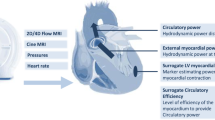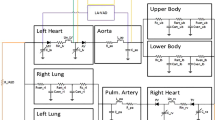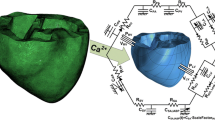Abstract
Severity assessment in concomitant hypertension (HT) and heart valve disease or multiple heart valve disease is vague, and there exists no established severity index. The objective of this study is to propose a theoretical framework to utilize the ventricular power overhead rates of HT, aortic regurgitation (AR), aortic stenosis (AS), and mitral regurgitation (MR) as a new means to assess severity, particularly under concomitant conditions. A lumped parameter model was utilized to evaluate the ventricular energy budget under normal, singular, and concomitant combinations of HT, AS, AR, and MR; and calculate energy overhead rate defined as the % increase in ventricular power output. Disease severity for each lesion was modeled at mild, moderate, and severe levels per AHA/ACC guidelines. The overhead rate for HT and AS were 15% (mild), 25% (moderate), and 45% (severe); AR and MR corresponded to 40% (moderate) and 100% (severe). The overhead rate as a function of regurgitant fraction was shown to be highly nonlinear. The overhead rate for concomitant lesions were 39% (mild HT+mild AS), 51% (mild HT+mild AR), 46% (mild HT+mild MR), 51% (mild AS+mild AR), 37% (mild AS+mild MR), and 44% (mild AR+mild MR). Power overhead under volume overload increases nonlinearly while that for pressure overload is linear. Concomitant lesions involving pressure (and volume?) overload produce a net overhead rate greater than the sum of individual lesions. Synergy in overhead rates is most with the presence of uncontrolled HT.










Similar content being viewed by others
References
Abdolrazaghi, M., M. Navidbakhsh, and K. Hassani. Mathematical modelling and electrical analog equivalent of the human cardiovascular system. Cardiovasc. Eng. 10:45–51, 2010.
Bonow, R. O., B. A. Carabello, K. Chatterjee, A. C. de Leon, D. P. Faxon, M. D. Freed, W. H. Gaasch, B. W. Lytle, R. A. Nishimura, P. T. O’Gara, R. A. O’Rourke, C. M. Otto, P. M. Shah, J. S. Shanewise, S. C. Smith, A. K. Jacobs, C. D. Adams, J. L. Anderson, E. M. Antman, V. Fuster, J. L. Halperin, L. F. Hiratzka, S. A. Hunt, R. Nishimura, R. L. Page, and B. Riegel. Amer Col Cardiology Amer, H., 2006. ACC/AHA 2006 guidelines for the management of patients with valvular heart disease. Circulation 114:E84–E231, 2006.
Chandran, K. B., A. P. Yoganathan, and S. E. Rittgers. Biofluid Mechanics: The Human Circulation. Routledge: Taylor and Francis, 2006.
Couet, J., M. Gaudreau, D. Lachance, E. Plante, E. Roussel, M. C. Drolet, and M. Arsenault. Treatment of combined aortic regurgitation and systemic hypertension: insights from an animal model study. Am. J. Hypertens. 19:843–850, 2006.
Dasi, L. P., K. Pekkan, D. de Zelicourt, K. S. Sundareswaran, R. Krishnankutty, P. J. Delnido, and A. P. Yoganathan. Hemodynamic energy dissipation in the cardiovascular system: generalized theoretical analysis on disease states. Ann. Biomed. Eng. 37:661–673, 2009.
Garcia, D., P. Pibarot, J. G. Dumesnil, F. Sakr, and L. G. Durand. Assessment of aortic valve stenosis severity—a new index based on the energy loss concept. Circulation 101:765–771, 2000.
Korakianitis, T., and Y. B. Shi. Numerical simulation of cardiovascular dynamics with healthy and diseased heart valves. J. Biomech. 39:1964–1982, 2006.
MacIsaac, A. I., I. G. McDonald, R. L. Kirsner, S. A. Graham, and D. Tanzer. Left ventricular energy in mitral regurgitation: a preliminary report. Aust. N Z J. Med. 22:532–540, 1992.
Pibarot, P., and J. G. Dumesnil. Improving assessment of aortic stenosis. J. Am. Coll. Cardiol. 60:169–180, 2012.
Rieck, A. E., D. Cramariuc, K. Boman, C. Gohlke-Barwolf, E. M. Staal, M. T. Lonnebakken, A. B. Rossebo, and E. Gerdts. Hypertension in aortic stenosis implications for left ventricular structure and cardiovascular events. Hypertension 60:90–97, 2012.
Stergiopulos, N., D. F. Young, and T. R. Rogge. Computer-simulation of arterial flow with applications to arterial and aortic stenoses. J. Biomech. 25:1477–1488, 1992.
Unger, P., C. Dedobbeleer, G. Van Camp, D. Plein, B. Cosyns, and P. Lancellotti. Mitral regurgitation in patients with aortic stenosis undergoing valve replacement. Heart 96:9–14, 2010.
Acknowlegment
This work was funded by the American Heart Association. Grant# 11SDG5170011.
Conflict of Interest Statement
Authors Canek Phillips, Rachael L. Simon-Walker, and Lakshmi Prasad Dasi declare that they have no conflict of interest.
Informed Consent Statement
No human studies were carried out by the authors for this article.
Animal Studies Statement
No animal studies were carried out by the authors for this article.
Author information
Authors and Affiliations
Corresponding author
Additional information
Associate Editor Ajit P. Yoganathan oversaw the review of this article.
Appendix: Estimating Power Overhead For AR and MR
Appendix: Estimating Power Overhead For AR and MR
Power Overhead for MR
Baseline: Let P be the mean ventricular pressure, and SV the stroke volume. Work done in one heart beat equals P*SV.
MR: Now, let RF be the mitral regurgitant fraction. If the net cardiac output is the same as baseline, then the ventricular stroke volume equals SV/(1 − RF). Work done in one heart beat equals P*SV/(1 − RF)
Rights and permissions
About this article
Cite this article
Phillips, C., Simon-Walker, R.L. & Dasi, L.P. Energy Costs of Singular and Concomitant Pressure and Volume Overload Lesions. Cardiovasc Eng Tech 5, 44–53 (2014). https://doi.org/10.1007/s13239-013-0173-3
Received:
Accepted:
Published:
Issue Date:
DOI: https://doi.org/10.1007/s13239-013-0173-3




